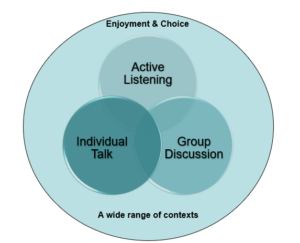Within our curriculum, the development of listening and talking skills is fundamental to all aspects of learning, communication and wellbeing. Learners will have regular opportunities to develop skills in the three core components as outlined in CfE: active listening, group discussion, and individual talk.
Through varied experiences across a wide range of contexts, learners will progressively develop the knowledge, understanding, and skills necessary to support effective communication. They should develop increasing levels of enjoyment, confidence and competence when communicating with others, as well as tools and techniques which enhance the communication of ideas and information.
The integration of the Listening and Talking CfE organisers within a responsive and inclusive curriculum helps learners develop as confident, effective communicators. By thoughtfully planning learning and providing targeted support where needed, practitioners can create the conditions for effective communication to flourish.
Assessment and Analysis
The Listening & Talking Assessment Resource Pack has been developed to support practitioners in planning, delivering, and moderating high-quality learning, teaching, and assessment of listening and talking skills. It offers a range of practical tools and guidance to promote an informed approach to key communication skills across all levels.
Core Resources
These materials are intended to be used flexibly but provide greater consistency across all schools and settings in Fife.
Contextualised Curriculum
In a contextualised curriculum, practitioners will intentionally integrate listening and talking opportunities throughout the learners’ educational experiences. This includes embedding language development into a range of classroom activities, from structured lessons to informal discussions, ensuring that learners are able to develop core skills through authentic contexts.
Responsive Routes
Being flexible to learners’ needs is crucial in supporting the development of listening and talking skills. Practitioners will take a responsive approach, adapting their teaching strategies based on assessment data and the specific needs of individual learners. By considering learners’ prior experiences and their home environments, practitioners will design learning experiences that ensure quality of input is prioritised over quantity and adapt their approaches through a variety of teaching strategies to ensure that every learner can make progress in their listening and talking development.
Inspiring Input
Practitioners will connect and engage with learners through positive, interactive communication that encourages active participation. By modelling effective listening and talking skills, practitioners will demonstrate both the structure and nuances of language, fostering a learning environment where learners feel safe, confident, and motivated to contribute to conversations.
Intentional Instruction
Practitioners will foster a positive, inclusive culture that encourages and supports dialogue within the classroom and across the wider school community. Effective communication practices will be modelled and reinforced consistently by all staff. Practitioners will ensure that their own communication with learners is authentic, nurturing, and promotes respectful interaction, providing both explicit and implicit opportunities for learners to recognise and practise key listening and talking skills.
Optimising Opportunities
Listening and talking skills will be explicitly taught and intentionally embedded through daily routines, activities, and instruction. Practitioners will provide structured opportunities for learners to develop active listening skills, group discussion behaviours, and individual speaking competencies. This will be achieved most effectively through an appropriate balance of teacher-led, teacher-directed and learner-led activities.
Professional Learning
A range of professional learning modules are available to help practitioners to continue building their knowledge and practice of our Core Approach in Fife — at their own pace, and in the areas most relevant to them or their school improvement priorities. These can be accessed in the Literacy Core Approach PL Materials section.

